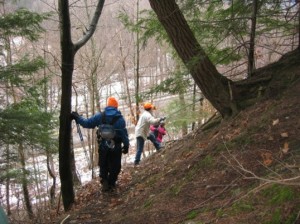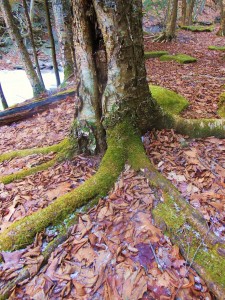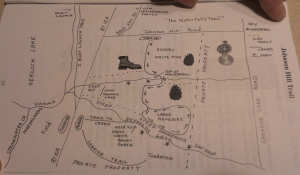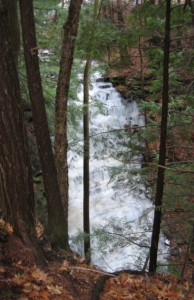 Weather Update: Some nice snow out here, should be pretty. Ice traks may be a good idea, but not deep enough for snowshoes.
Weather Update: Some nice snow out here, should be pretty. Ice traks may be a good idea, but not deep enough for snowshoes.
For those that remember the “golden tree” that Linda Slade found “once upon a 2011 hike”, Bob attempting to pull himself up a cliff by rope, and Mac and Duff walking at the top of a ice covered waterfall, we will return to the Johnson Hill Trail this coming Sunday. Note due to the muddy, rutted and apparently logging activity at Rattlesnake Hill, we have changed this week’s hike to a closer location. According to the new naming of the DEC Hemlock/Canadice State Forest trails, this trail is also called Willow Oak and is located just off Rt 15A on Johnson Hill Road.  On your way to or after the hike you may want to take an alternative route on Old Bald Hill Road South for a spectacular view of the Springwater Valley and Creek. We will meet at 1:45 at the trail head parking lot at the entrance to the South Boat Launch of Hemlock Lake. A tailgate social will follow the hike across the road at Reynolds Gull.
On your way to or after the hike you may want to take an alternative route on Old Bald Hill Road South for a spectacular view of the Springwater Valley and Creek. We will meet at 1:45 at the trail head parking lot at the entrance to the South Boat Launch of Hemlock Lake. A tailgate social will follow the hike across the road at Reynolds Gull.
Also called the “Waterfall Trail” this mile and half trail passes through a hilly, deciduous forested area that accommodates hiking, snow shoeing and cross country skiing.  The trail passes through oak, hickory, white pine, black oak, tupelo and eastern hemlock forests. Most spectacular in the winter and spring is a double waterfall which offers outstanding photographic opportunities. Skirting along the upper ridge of Reynolds Gull, the roar of another waterfall deep within the gorge can often be heard but not seen due to the dangerous undercut. (map of Johnson Hill Trail from Hiking the Little Finger Lakes)
The trail passes through oak, hickory, white pine, black oak, tupelo and eastern hemlock forests. Most spectacular in the winter and spring is a double waterfall which offers outstanding photographic opportunities. Skirting along the upper ridge of Reynolds Gull, the roar of another waterfall deep within the gorge can often be heard but not seen due to the dangerous undercut. (map of Johnson Hill Trail from Hiking the Little Finger Lakes)
 Trail conditions can change from mud to hard mud, ice to snow, 50 degrees to 5 degrees in January, so be prepared. Naturalists will stay on the trail, take time by the waterfall and creek to explore, and hike at their ability level. The upper part of the trail can be bit steep, but if taken slowly, it is worth it. A side trail can offer a view of Hemlock Lake. Tourists and Climbers will hike the entire trail at their speed level, exploring adjacent lands on both sides of Reynolds Gull or down to Hemlock Lake for extended hikes.
Trail conditions can change from mud to hard mud, ice to snow, 50 degrees to 5 degrees in January, so be prepared. Naturalists will stay on the trail, take time by the waterfall and creek to explore, and hike at their ability level. The upper part of the trail can be bit steep, but if taken slowly, it is worth it. A side trail can offer a view of Hemlock Lake. Tourists and Climbers will hike the entire trail at their speed level, exploring adjacent lands on both sides of Reynolds Gull or down to Hemlock Lake for extended hikes.
Our after hike social will be a tailgate in the parking area at the Reynolds Gull Creek. Similar to last year, a camping stove, gas grill, and hot dogs will be provided. Bring a dish to pass and your drink of preference, or make a small ($5) contribution toward the social funds.
Directions: Rt 15A to Springwater. We will meet at the large parking lot at the entrance to
the South Boat Launch at Hemlock Lake. From the large parking lot some hikers will car pool up to the small parking lot on Johnson Hill Road if parking conditions are acceptable.




